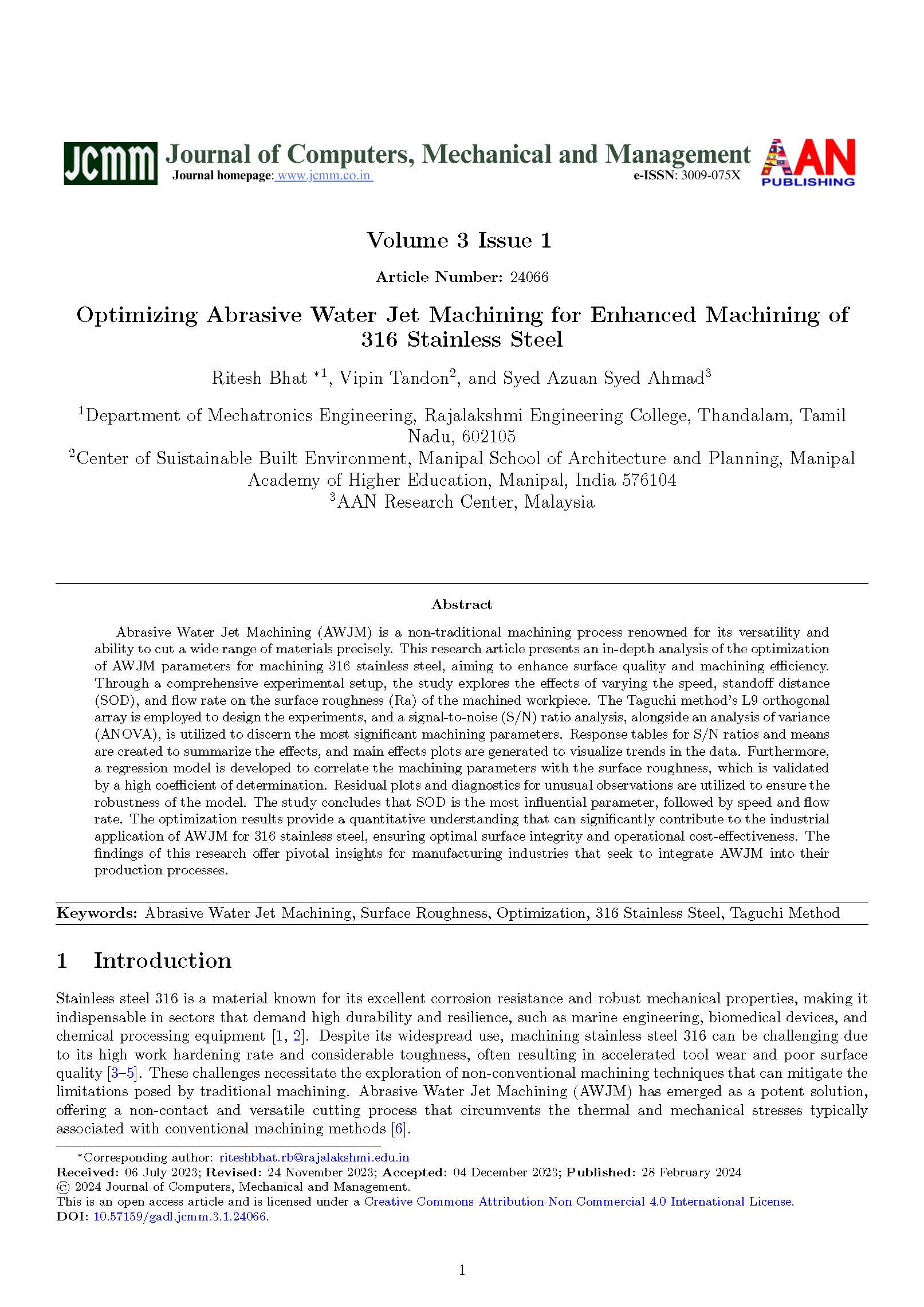Optimizing Abrasive Water Jet Machining for Enhanced Machining of 316 Stainless Steel
DOI:
https://doi.org/10.57159/gadl.jcmm.3.1.24066Keywords:
Abrassive Wear Jet Machining, Surface Roughness, Optimization, 316 Stainless Steel, Taguchi MethodAbstract
Abrasive Water Jet Machining (AWJM) is a non-traditional machining process renowned for its versatility and ability to cut a wide range of materials precisely. This research article presents an in-depth analysis of the optimization of AWJM parameters for machining 316 stainless steel, aiming to enhance surface quality and machining efficiency. Through a comprehensive experimental setup, the study explores the effects of varying the speed, standoff distance (SOD), and flow rate on the surface roughness (Ra) of the machined workpiece. The Taguchi method's L9 orthogonal array is employed to design the experiments, and a signal-to-noise (S/N) ratio analysis, alongside an analysis of variance (ANOVA), is utilized to discern the most significant machining parameters. Response tables for S/N ratios and means are created to summarize the effects, and main effects plots are generated to visualize trends in the data. Furthermore, a regression model is developed to correlate the machining parameters with the surface roughness, which is validated by a high coefficient of determination. Residual plots and diagnostics for unusual observations are utilized to ensure the robustness of the model. The study concludes that SOD is the most influential parameter, followed by speed and flow rate. The optimization results provide a quantitative understanding that can significantly contribute to the industrial application of AWJM for 316 stainless steel, ensuring optimal surface integrity and operational cost-effectiveness. The findings of this research offer pivotal insights for manufacturing industries that seek to integrate AWJM into their production processes.
References
K. Lakkam, S. M. Kerur, and A. Shirahatti, “Effect of pitting corrosion on the mechanical properties of 316 grade stainless steel,” Materials Today: Proceedings, vol. 27, pp. 497–502, 2020.
S. Thaiwatthana, X.-Y. Li, H. Dong, and T. Bell, “Mechanical and chemical properties of low temperature plasma surface alloyed 316 austenitic stainless steel,” Surface engineering, vol. 18, no. 2, pp. 140–144, 2002.
J. Nomani, A. Pramanik, T. Hilditch, and G. Littlefair, “Chip formation mechanism and machinability of wrought duplex stainless steel alloys,” The International Journal of Advanced Manufacturing Technology, vol. 80, pp. 1127– 1135, 2015.
L. W. H. Gonz´alez, Y. S. Ahmed, D. A. C. Sosa, and R. P. Rodr´ıguez, “Enhancing aisi d2 steel milling: Balancing surface quality and tool life,” 2023.
A. E.-s. Abdelaziz, A. M. A. Elkaseer, and A. E.-s. Nassef, “Tool wear and surface roughness in hard turning of stainless steel 316 using tungsten carbide tool.” MEJ-Mansoura Engineering Journal, vol. 40, no. 5, pp. 73–82, 2021.
K. Kalita, S. Chakraborty, R. K. Ghadai, and S. Chakraborty, “Parametric optimization of non-traditional machining processes using multi-criteria decision making techniques: Literature review and future directions,” Multiscale and Multidisciplinary Modeling, Experiments and Design, vol. 6, no. 1, pp. 1–40, 2023.
H. Wang, R. Yuan, X. Zhang, P. Zai, and J. Deng, “Research progress in abrasive water jet processing technology,” Micromachines, vol. 14, no. 8, p. 1526, 2023.
A. Kale, S. Singh, N. Sateesh, and R. Subbiah, “A review on abrasive water jet machining process and its process parameters,” Materials Today: Proceedings, vol. 26, pp. 1032–1036, 2020.
R. Melentiev and F. Fang, “Recent advances and challenges of abrasive jet machining,” CIRP Journal of Manufacturing Science and technology, vol. 22, pp. 1–20, 2018.
A. Anu Kuttan, R. Rajesh, and M. Dev Anand, “Abrasive water jet machining techniques and parameters: a state of the art, open issue challenges and research directions,” Journal of the Brazilian Society of Mechanical Sciences and Engineering, vol. 43, pp. 1–14, 2021.
M. K. Singh, R. Trehan, and A. Gupta, “Application of grey approach to enhance the surface properties during AWJ machining of marine grade inconel,” Advances in Materials and Processing Technologies, vol. 7, no. 3, pp. 429–445, 2021.
M. K. Gawade and V. S. Jatti, “To study and optimize the effects of process parameters on taper angle of stainless steel by using abrasive water jet machining,” in Techno-Societal 2020: Proceedings of the 3rd International Conference on Advanced Technologies for Societal Applications—Volume 1, pp. 983–993, Springer, 2021.
S. Rammohan, “Investigation on the performance of abrasive waterjet machining on armor steel,” 2023.

Downloads
Published
How to Cite
Issue
Section
License
Copyright (c) 2023 Journal of Computers, Mechanical and Management

This work is licensed under a Creative Commons Attribution-NonCommercial 4.0 International License.
The Journal of Computers, Mechanical and Management applies the CC Attribution- Non-Commercial 4.0 International License to its published articles. While retaining copyright ownership of the content, the journal permits activities such as downloading, reusing, reprinting, modifying, distributing, and copying of the articles, as long as the original authors and source are appropriately cited. Proper attribution is ensured by citing the original publication.





